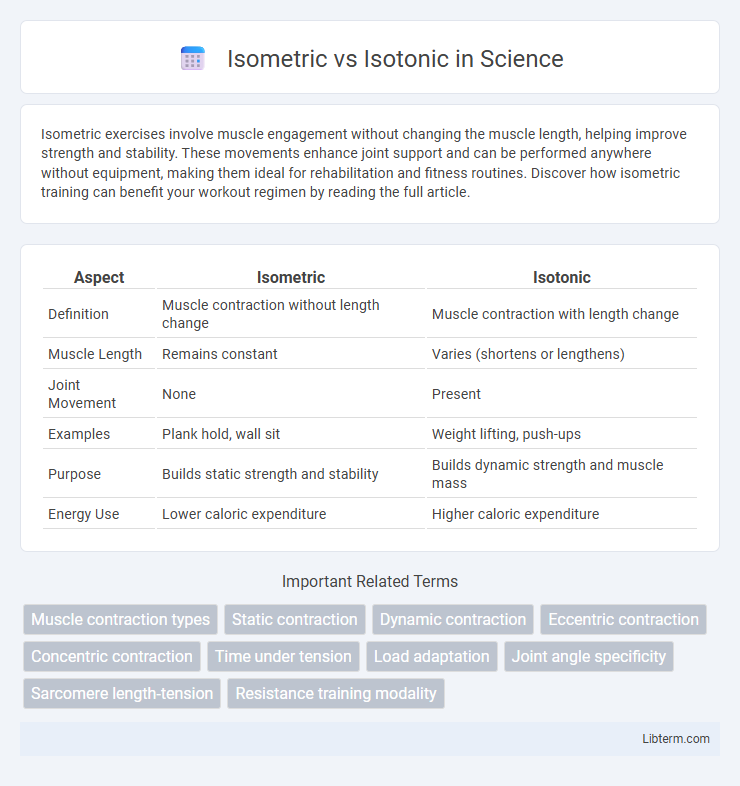Isometric exercises involve muscle engagement without changing the muscle length, helping improve strength and stability. These movements enhance joint support and can be performed anywhere without equipment, making them ideal for rehabilitation and fitness routines. Discover how isometric training can benefit your workout regimen by reading the full article.
Table of Comparison
| Aspect | Isometric | Isotonic |
|---|---|---|
| Definition | Muscle contraction without length change | Muscle contraction with length change |
| Muscle Length | Remains constant | Varies (shortens or lengthens) |
| Joint Movement | None | Present |
| Examples | Plank hold, wall sit | Weight lifting, push-ups |
| Purpose | Builds static strength and stability | Builds dynamic strength and muscle mass |
| Energy Use | Lower caloric expenditure | Higher caloric expenditure |
Introduction to Isometric and Isotonic Exercises
Isometric exercises involve muscle contractions without changing the muscle length, such as planks or wall sits, effectively enhancing static strength and stability. Isotonic exercises consist of dynamic movements where muscles change length through concentric and eccentric phases, like squats or push-ups, promoting muscle growth and endurance. Both exercise types play crucial roles in fitness by targeting different aspects of muscular performance and rehabilitation protocols.
Defining Isometric Exercises
Isometric exercises involve muscle contractions without joint movement, where the muscle length remains constant while generating force. These exercises improve static strength and stability by activating muscle fibers without changing the muscle's angle or length. Common examples include planks, wall sits, and holding a squat position.
Understanding Isotonic Exercises
Isotonic exercises involve dynamic muscle contractions where the muscle changes length while lifting or lowering a load, such as in weightlifting or bodyweight movements like push-ups and squats. These exercises improve muscle strength and endurance by combining concentric (muscle shortening) and eccentric (muscle lengthening) phases, enhancing overall functional fitness. Examples include bicep curls, bench presses, and lunges that require consistent resistance through a full range of motion.
Key Differences Between Isometric and Isotonic
Isometric exercises involve muscle contraction without changing muscle length, such as planks, which aid in static strength and stability. Isotonic exercises produce muscle contraction with movement, including concentric and eccentric phases like bicep curls, promoting dynamic muscle development and joint mobility. Key differences include muscle length change, joint movement presence, and specific fitness benefits targeting endurance, strength, or flexibility.
Benefits of Isometric Training
Isometric training offers significant benefits by improving muscle strength and endurance without joint movement, making it ideal for rehabilitation and injury prevention. This type of exercise enhances static strength, stabilizing muscles around joints and reducing the risk of strains during dynamic activities. Isometric holds also promote greater muscle activation and can be performed anywhere, requiring minimal equipment for effective strength gains.
Advantages of Isotonic Movements
Isotonic movements enhance muscle strength and endurance by allowing muscles to contract through a full range of motion, leading to improved functional fitness. They promote better joint mobility and flexibility, reducing the risk of injury during everyday activities and sports. Furthermore, isotonic exercises boost cardiovascular health by increasing heart rate and circulation during dynamic muscle contractions.
Common Examples of Isometric vs Isotonic Exercises
Common examples of isometric exercises include planks, wall sits, and static yoga poses, which involve muscle engagement without joint movement. Isotonic exercises, such as push-ups, squats, and bicep curls, feature dynamic contractions where muscles change length through concentric and eccentric phases. Both exercise types enhance strength, but isotonic movements improve muscle endurance and mobility more effectively.
Safety Considerations and Injury Prevention
Isometric exercises involve muscle contraction without joint movement, reducing the risk of joint strain, making them safer for individuals with joint issues or during rehabilitation. Isotonic exercises, which involve dynamic muscle contractions with movement, require proper form and controlled motion to prevent injuries such as strains or tendonitis. Prioritizing gradual progression, adequate warm-up, and correct technique is essential to minimize injury risks in both isometric and isotonic training.
Choosing the Right Exercise Type for Your Goals
Isometric exercises involve muscle contraction without movement, ideal for building static strength and improving joint stability, while isotonic exercises feature dynamic muscle contractions with movement, promoting muscle growth and endurance. Choosing the right exercise depends on your fitness goals: isometrics suit rehabilitation and strength maintenance, whereas isotonic workouts enhance functional strength and cardiovascular health. Incorporating both types strategically can optimize overall performance and injury prevention.
Conclusion: Isometric or Isotonic—Which Is Best for You?
Isometric exercises build static strength by engaging muscles without changing their length, ideal for improving stability and joint support. Isotonic exercises involve dynamic muscle contractions with movement, enhancing muscle endurance and functional strength through a full range of motion. Choosing between isometric and isotonic workouts depends on fitness goals, injury considerations, and the need for either muscle control or mobility development.
Isometric Infographic

 libterm.com
libterm.com